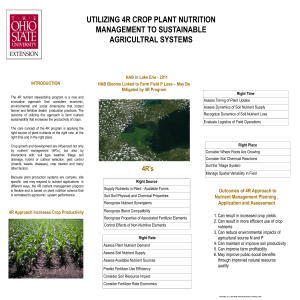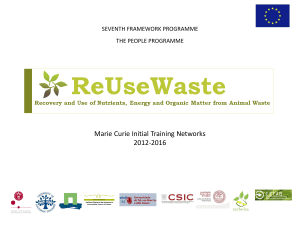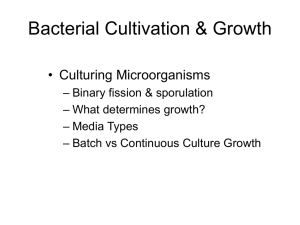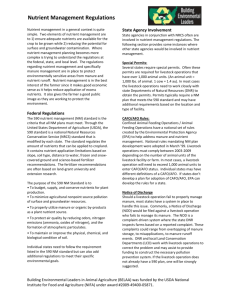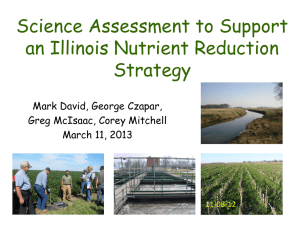Nutrient Management Planning
advertisement
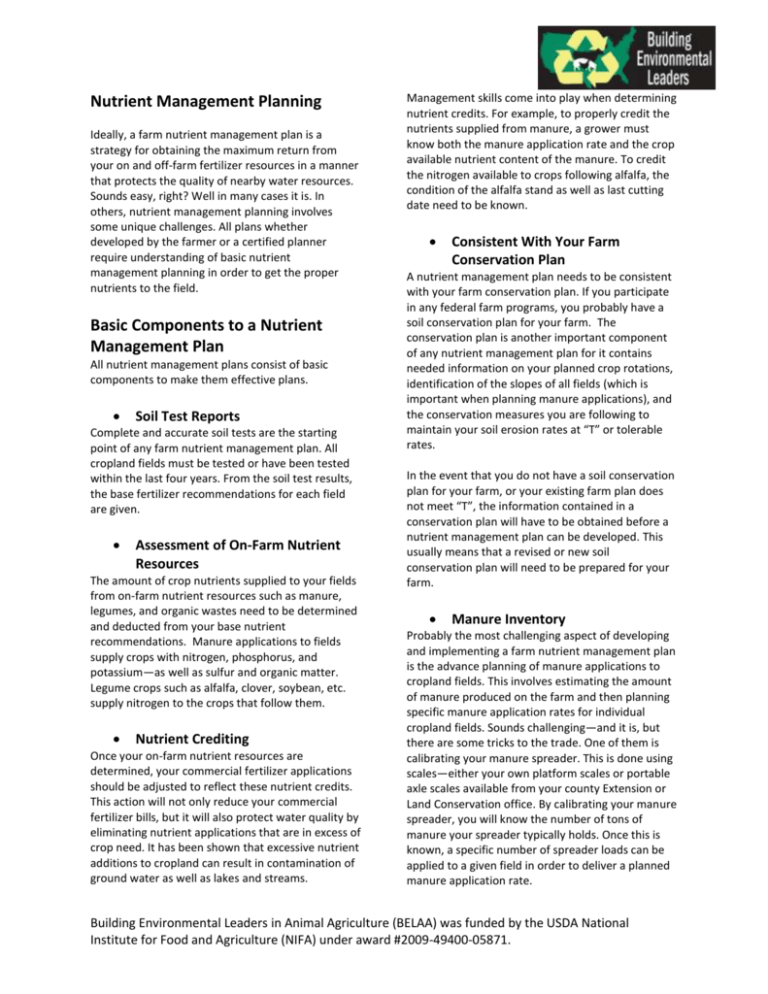
Nutrient Management Planning Ideally, a farm nutrient management plan is a strategy for obtaining the maximum return from your on and off-farm fertilizer resources in a manner that protects the quality of nearby water resources. Sounds easy, right? Well in many cases it is. In others, nutrient management planning involves some unique challenges. All plans whether developed by the farmer or a certified planner require understanding of basic nutrient management planning in order to get the proper nutrients to the field. Basic Components to a Nutrient Management Plan All nutrient management plans consist of basic components to make them effective plans. Soil Test Reports Complete and accurate soil tests are the starting point of any farm nutrient management plan. All cropland fields must be tested or have been tested within the last four years. From the soil test results, the base fertilizer recommendations for each field are given. Assessment of On-Farm Nutrient Resources The amount of crop nutrients supplied to your fields from on-farm nutrient resources such as manure, legumes, and organic wastes need to be determined and deducted from your base nutrient recommendations. Manure applications to fields supply crops with nitrogen, phosphorus, and potassium—as well as sulfur and organic matter. Legume crops such as alfalfa, clover, soybean, etc. supply nitrogen to the crops that follow them. Nutrient Crediting Once your on-farm nutrient resources are determined, your commercial fertilizer applications should be adjusted to reflect these nutrient credits. This action will not only reduce your commercial fertilizer bills, but it will also protect water quality by eliminating nutrient applications that are in excess of crop need. It has been shown that excessive nutrient additions to cropland can result in contamination of ground water as well as lakes and streams. Management skills come into play when determining nutrient credits. For example, to properly credit the nutrients supplied from manure, a grower must know both the manure application rate and the crop available nutrient content of the manure. To credit the nitrogen available to crops following alfalfa, the condition of the alfalfa stand as well as last cutting date need to be known. Consistent With Your Farm Conservation Plan A nutrient management plan needs to be consistent with your farm conservation plan. If you participate in any federal farm programs, you probably have a soil conservation plan for your farm. The conservation plan is another important component of any nutrient management plan for it contains needed information on your planned crop rotations, identification of the slopes of all fields (which is important when planning manure applications), and the conservation measures you are following to maintain your soil erosion rates at “T” or tolerable rates. In the event that you do not have a soil conservation plan for your farm, or your existing farm plan does not meet “T”, the information contained in a conservation plan will have to be obtained before a nutrient management plan can be developed. This usually means that a revised or new soil conservation plan will need to be prepared for your farm. Manure Inventory Probably the most challenging aspect of developing and implementing a farm nutrient management plan is the advance planning of manure applications to cropland fields. This involves estimating the amount of manure produced on the farm and then planning specific manure application rates for individual cropland fields. Sounds challenging—and it is, but there are some tricks to the trade. One of them is calibrating your manure spreader. This is done using scales—either your own platform scales or portable axle scales available from your county Extension or Land Conservation office. By calibrating your manure spreader, you will know the number of tons of manure your spreader typically holds. Once this is known, a specific number of spreader loads can be applied to a given field in order to deliver a planned manure application rate. Building Environmental Leaders in Animal Agriculture (BELAA) was funded by the USDA National Institute for Food and Agriculture (NIFA) under award #2009-49400-05871. Manure Spreading Plan The majority of any nutrient management plan for farms with livestock will deal with a manure spreading plan. The amount of manure the farm produces has to be applied to fields in a manner that makes sense both environmentally and agronomically. Planned manure applications should be made at rates that do not exceed crop nutrient need as identified in the soil test report. The nutrient management plan will also prioritize those fields that would benefit the most from the manure-supplied nutrients while posing little threat to water quality. Also, the nutrient management plan will identify those fields that have manure spreading restrictions. Examples of such restrictions would be fields adjacent to lakes and streams, sloping fields where the threat of spring runoff prohibits manure applications in the winter, and fields in the vicinity of wells, sinkholes, or fractured bedrock. Crop Plan The key to a successful nutrient management plan is to implement it. The crop plan is where the nutrient management plan gets implemented. The crop plan is an annual plan which dictates what crop will be planted in specific fields in order to make best use of available nutrients and meet environmental goals such as limiting soil and nutrient loss. The crop plan consists of several pieces of information for each field in the nutrient management plan. These include, the crop to be grown and nutrients required for that crop, yield goals, current soil test levels, previous year’s crop, nutrient credits from previous crop (if any), type and rate of manure to be applied, and commercial fertilizer applied. The crop plan can be a hand-written plan or developed using a computer software program. Several states have developed nutrient management planning software programs. From inputted data, these programs can automatically calculate nutrient needs, soil loss, and environmental impact such as potential phosphorous loading to nearby surface waters. An example of a nutrient management planning software program is Wisconsin’s SNAP-Plus Nutrient Management Software which is available at http://www.snapplus.net/ Maps Two types of maps are needed for a nutrient management plan. One map is called a restriction map which identifies areas where manure can or cannot be applied or is restricted under certain conditions. Prohibited areas where manure should never be applied include grassed waterways, surface waters, sinkholes, buffer strips, or near water wells. Restricted areas are areas where manure can be applied but only when conditions are suitable. An example of a restricted area would be a winter manure application setback of 1000 feet from a lake or pond. This would mean if manure is to be spread in the winter; the manure cannot be applied within 1000 feet from the lake or pond. Other restrictions can be related to the time of year manure can be spread, slope of the land, and proximity to surface water or wells. Check with local state Natural Resource Conservation Service agency for examples of restriction maps http://www.nrcs.usda.gov/ The other type of map needed for a nutrient management plan is an application map which identifies the manure application rate and the field where it will be applied. This map is especially important if using a professional custom manure applicator. The map ensures the right application rate is being applied to the right field. The restriction map and the application map can often be the same map as long as all information is included in a clear manner. The 590 Nutrient Management Standard You may have heard or read about something called the “590 standard” and you might be wondering what it is and what it has to do with nutrient management planning. The 590 standard is a USDANatural Resources Conservation Service document that defines the minimum requirements and components of an acceptable nutrient management plan. A nutrient management plan meeting the 590 standard is a requirement for participation in some federal and state farm programs involving costsharing. A farm nutrient management plan that meets the 590 standard is also a requirement of some county ordinances dealing with the construction of manure storage facilities or livestock expansion. Activity: Develop a restriction map with restricted and prohibited areas clearly marked. Sources: What is a Nutrient Management Plan?, Nutrient and Pest Management Program, University of Wisconsin- Extension and University of Wisconsin-Madison, College of Agricultural and Life Sciences.
